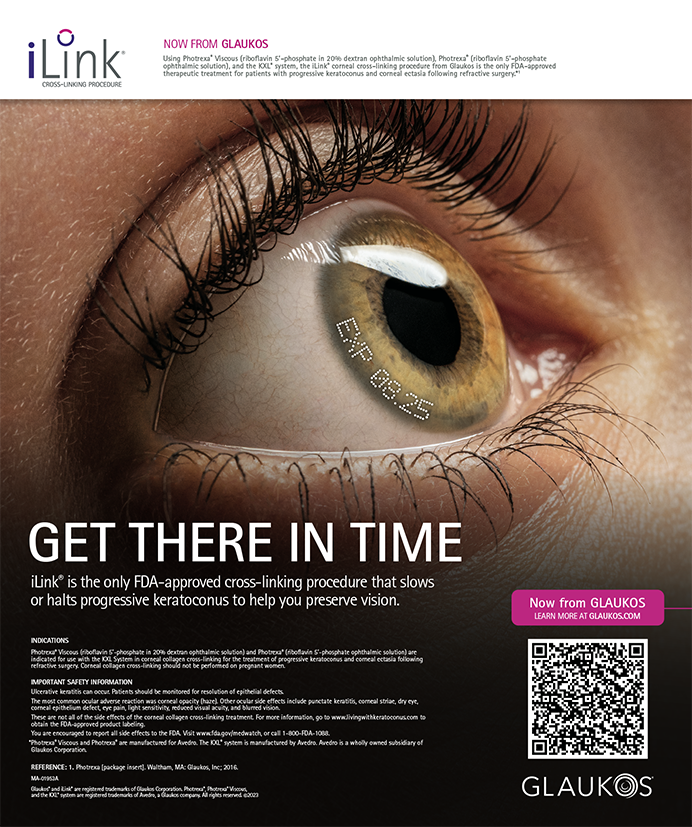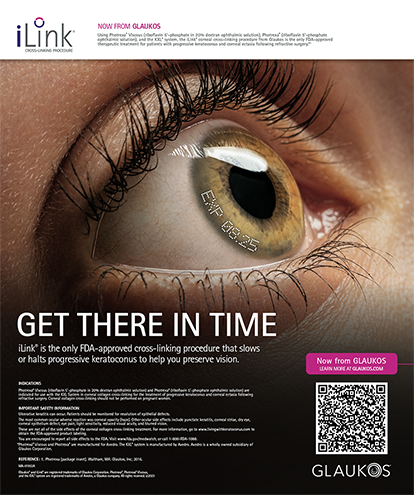When the anterior chamber becomes shallow during phacoemulsification, the surgeon must promptly evaluate its potential cause. A decisive determinant in the differential diagnosis is the hardness of the globe, which the surgeon must palpate. Firmness signals positive pressure; softness indicates its absence. Cataract surgeons need to understand the causes of a shallow anterior chamber and the pathogenesis and treatment of positive pressure.
A SHALLOW ANTERIOR CHAMBER
No Positive Pressure
When no positive pressure is present (ie, a soft globe), the anterior chamber's shallowness may be due to excessive fluid outflow through the paracentesis or the main incision. Another cause is an excessively high flow setting that is pulling a large volume of fluid out of the anterior chamber through the phaco needle. The absence of positive pressure can also be due to inadequate inflow because of an obstruction in the phaco tip's sleeve (eg, in a tight wound), an insufficient bottle height, or a disconnection of irrigation from the phaco tip.
If the eye is soft, the remedy is to correct the cause and continue surgery.
Posterior Positive Pressure
Posterior positive pressure (ie, a firm globe) may be due to a retobulbar, periorbital, or conjunctival hemorrhage; mechanical pressure; a tight speculum/drapes; fluid misdirection syndrome; or a suprachoroidal effusion or hemorrhage.
Determining how to proceed is an entirely different process when the eye is hard versus soft. It is easy to remedy a mechanical cause, such as tight drapes or speculum. A conjunctival hemorrhage is typically not so severe as to prevent the completion of the cataract procedure. A peribulbar/retrobulbar hemorrhage, if sizeable, however, requires a postponement of 24 to 48 hours. The diagnosis of diverted fluid or a peribulbar/retrobulbar hemorrhage is essential to deciding whether to continue or abort the procedure.
FLUID DEVIATION SYNDROME
Mechanism
Fluid deviation syndrome has gone by various names such as aqueous misdirection, ciliary block, and malignant glaucoma (in the postoperative setting). The etiology is similar in all circumstances: the diversion of aqueous or balanced salt solution behind the zonulocapsular diaphragm into the vitreous creates high pressure within the posterior segment. This situation can lead to pupillary block and angle closure as the lens and iris shift forward, exacerbating the elevation of IOP. When the ciliary body rotates anteriorly, the chamber shallows, and during surgery, the iris may prolapse. If the surgeon continues to infuse fluid, the eye will become firmer. Assisted by an intact vitreous face, the zonulocapsular diaphragm acts like a one-way valve; balanced salt solution gets into the posterior segment and is blocked from reentry into the anterior chamber by the vitreous valve.
The deviation may occur as fluid passes through the intact zonule (Figure 1) or through a rent in the posterior capsule1 (Figure 2).
Predisposition
Fluid deviation can occur whenever there is infusion, whether by cannula, infusion bottle, or ophthalmic viscosurgical device (OVD). During hydrodissection, surgeons may inadvertently place the cannula over the anterior capsule. A subsequent injection forces fluid through the zonules into the vitreous. Alternatively, the injection of balanced salt solution under the anterior capsule may elevate the capsule against the iris, thereby creating pupillary block and forcing fluid through the intact zonule. Both scenarios are more likely in the presence of a small pupil, which hinders visualization of the hydrodissection cannula.
During phacoemulsification, surgeons may force the fluid posteriorly if a cohesive OVD prevents anterior fluid circulation, particularly if the infusion bottle is high. Similarly, with an occult radial capsular tear or small area of zonulysis, the intact vitreous face closes the one-way valve and triggers an increase in posterior pressure.
Treatment
Upon recognizing positive pressure, the surgeon should remove the irrigating instrument from the eye. He or she must rule out a suprachoroidal effusion/hemorrhage as the etiology of the increased IOP by examining the periphery with an indirect ophthalmoscope. Alternatively, Robert Osher, MD, developed a fundus lens for the examination of the periphery that can be presterilized, wrapped, and utilized in just such an emergency.2 After verifying that a suprachoroidal effusion/hemorrhage has not occurred, the surgeon has several options for how to proceed:
- apply digital counter pressure and wait approximately 20 minutes
- continue the procedure when the eye softens
- lower the bottle (rather than raise it) to decrease fluid inflow (the objective is to avoid pushing more fluid into the posterior segment)
- administer intravenous Diamox (500 mg IV push [Duramed Pharmaceuticals Inc., Cincinnati, OH]) and/or mannitol (1 to 2 g/kg 25% solution). If all else fails, pars plana aspiration of liquid vitreous
ACUTE SUPRACHOROIDAL EFFUSION/HEMORRHAGE
Mechanism
The sequence of events leading to a suprachoroidal hemorrhage begins with transudation of fluid from the choriocapillaris. A uveal effusion occurs because of the pressure differential between the intravascular blood and the intraocular fluid.3 Once the eye is decompressed for surgery, the IOP falls. The effusion fills the spongy choroidal space between Bruch's membrane and the sclera. The larger choroidal vessels stretch between the sclera and choriocapillaris until a rupture occurs in one of the short posterior ciliary vessels. The hemorrhage into the suprachoroidal space hastens the expansion and leads to more ruptured vessels. If the surgeon does nothing to stop this cascade, the hemorrhage will detach the ciliary body and tear the higher-pressure ciliary vessels (Figure 3). This massive bleed near the pars plana will propel the iris, lens, vitreous, retina, and uvea out through the incision, if it is large enough that the surgeon cannot prevent expulsion.4 The event may begin relatively slowly only to end with the speed of an explosion.
Because a drop in IOP appears to be a causative factor in the initiation of the aforementioned sequence, the most likely times for its activation are
- when the OVD is irrigated from the anterior chamber at the initiation of hydrosteps
- upon the phaco tip's removal from the anterior segment at the end of phacoemulsification
- when the I/A tip is removed from the anterior segment at the completion of I/A and immediately before the injection of an OVD for the IOL's insertion
- upon the OVD's removal before the surgeon fills the anterior segment to normalize the IOP for the completion of the case
Although a decrease in the IOP is necessary to initiate the cascade of events from effusion to hemorrhage to expulsion, other factors also play a role (see Predisposing Factors for a Suprachoroidal Hemorrhage). Addressing these factors prior to surgery should lessen the risk of this event.
Although not a predisposing factor, anticoagulation with aspirin, Plavix (clopidogrel bisulfate; Bristol Myers Squibb Company, New York, NY), or Coumadin (warfarin sodium; Bristol-Myers Squibb Company) theoretically could increase the possibility that, once a suprachoroidal hemorrhage has occurred, it will proceed rapidly.
Davison has reported the incidence of suprachoroidal effusion. He noted that the incidence varies depending on the phaco technique. In his original 1986 study of acute intraoperative suprachoroidal hemorrhage, he reported an incidence of 0.81% with iris plane emulsification.5 By 1993, using a capsular bag phaco technique that reduced the amplitude of swings in IOP, his incidence had dropped to 0.06%.6 Arnold also showed that maintaining anterior segment pressure by constructing watertight incisions and reducing intracameral pressure fluctuations lessens the incidence of suprachoroidal effusion from 0.45% of all phaco cases to 0.08%.1
TREATMENT
An important factor in achieving a successful resolution of suprachoroidal effusion/hemorrhage is the rapidity with which the surgeon recognizes the event. If the eye has become rock hard, a suprachoroidal effusion/hemorrhage is in progress. The patient may complain of pain despite adequate anesthesia; there is a rich supply of ciliary nerves throughout the choroid. Rather than waste time on other diagnostic tests at this juncture, the surgeon should immediately close the incision, with sutures if necessary, and apply digital counter pressure. External anterior pressure will increase the IOP and tamponade the effusion or hemorrhage. It is very important to limit the effusion or small hemorrhage to avoid stretching and rupturing of the larger choroidal vessels in the suprachoroidal space. Maintaining the uveal anatomy limits the tangential shearing force of the effusion and prevents a large hemorrhage. The surgeon should use a suture material that has high tensile strength and is easily handled. At this point, he or she can diagnose and confirm the presence of suprachoroidal effusion/hemorrhage by performing indirect ophthalmoscopy or scleral transillumination (Figure 4).
Retinal circulation is threatened during episodes of acute intraoperative suprachoroidal hemorrhage, but applying significant anterior pressure is necessary to prevent an expulsive hemorrhage. Hayreh and Weingeist have shown that retinal ischemia is tolerated for 90 to 100 minutes, with good recovery of visual evoked responses and retinal morphology; ischemia beyond the aforementioned time results in irreparable retinal damage.7 Performing a sclerotomy to drain fluid or blood from the suprachoroidal space is contraindicated. The goal is to tamponade the hemorrhage, and a sclerotomy serves only to allow additional hemorrhage. Moreover, enlarging the incision for any reason is inadvisable, because it can lead to a true expulsive hemorrhage.
After controlling the initial pressure spike, the surgeon can address the intraoperative elevation in pressure as well as the inevitable postoperative rise in IOP by initiating systemic therapy with Diamox (500 mg intravenous push) and/or mannitol (1 to 2 g/kg 25% solution). Although an unproven measure, the surgeon may add 100 mg of intravenous hydrocortisone in an attempt to reduce vascular permeability and ocular inflammation.1 The surgeon then abandons the cataract procedure. There is no reason to attempt to continue, because the risk of numerous complications outweighs the potential benefit. After waiting 1 day to 1 week for the eye to stabilize, the ophthalmologist can complete cataract surgery.
CONCLUSION
When performing phacoemulsification, the cataract surgeon must be ready to recognize, diagnose, and treat any impending complication. By understanding the pathogenesis and treatment of positive pressure, he or she can prevent this unexpected event from leading to a cascade of further complications.
William J. Fishkind, MD, is the codirector of Fishkind and Bakewell Eye Care and Surgery Center in Tucson, Arizona, clinical professor of ophthalmology at the University of Utah, and clinical instructor at the University of Arizona. He acknowledged no financial interest in the products or companies mentioned herein. Dr. Fishkind may be reached at (520) 293-6740 ext. 109; wfishkind@earthlink.net.


